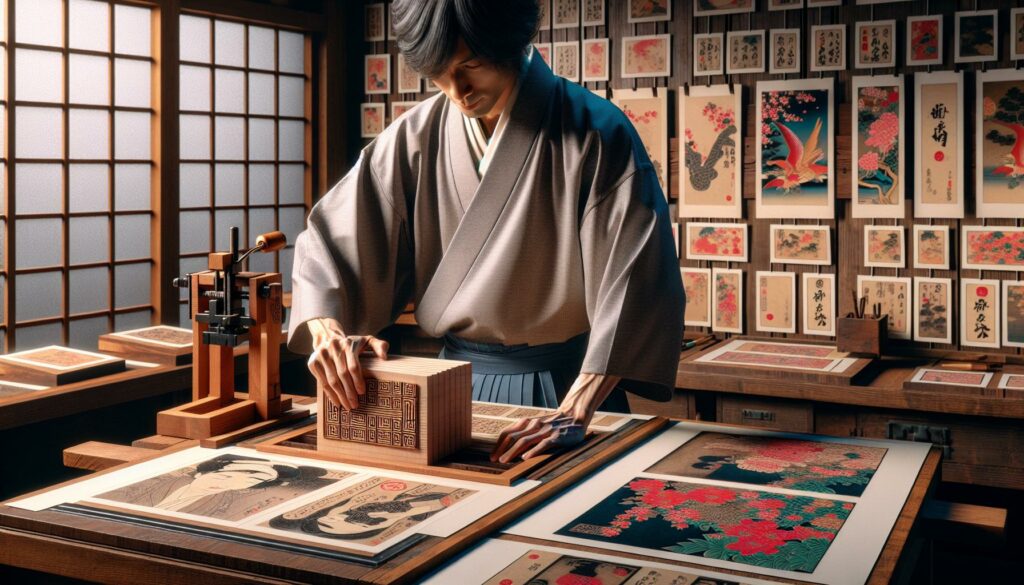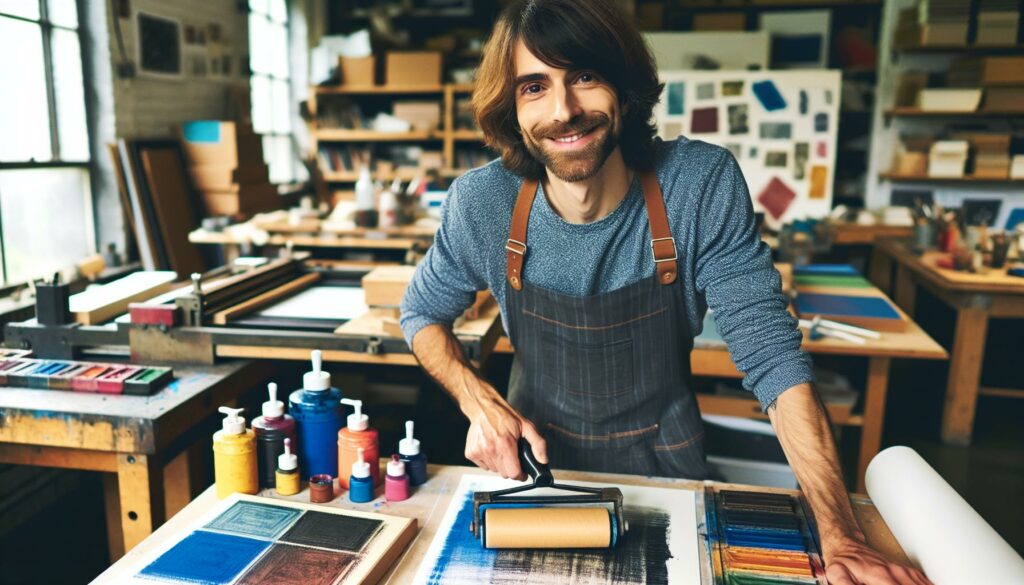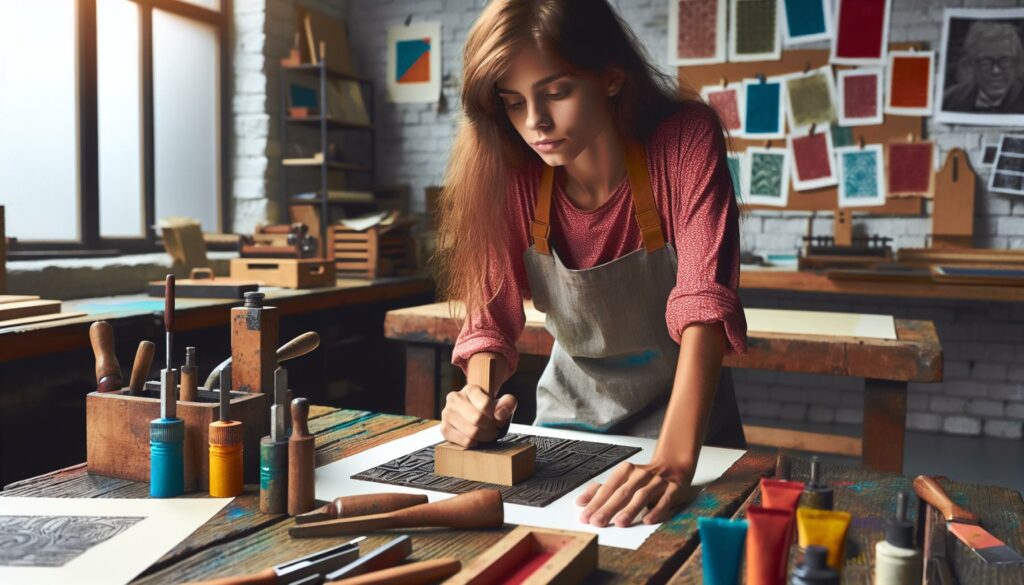Japanese printmaking captivates me with its rich history and intricate techniques. Originating centuries ago, this art form combines beauty and craftsmanship, reflecting Japan’s cultural heritage and artistic evolution. From the delicate lines of ukiyo-e to the vibrant colors of modern prints, each piece tells a story that resonates with viewers around the world.
As I delve into the world of Japanese printmaking, I find the meticulous process fascinating. Artists employ a blend of traditional methods and contemporary innovations, creating stunning works that bridge the past and present. Whether you’re an art enthusiast or simply curious about this unique craft, exploring Japanese printmaking offers a glimpse into a timeless tradition that continues to inspire and enchant.
Key Takeaways
- Japanese printmaking has a rich history, with ukiyo-e prints originating in the early 17th century and becoming renowned for their intricate beauty.
- The printmaking process involves collaboration between artists and skilled craftsmen, with each color requiring a separate carved woodblock for precise alignment.
- Traditional materials like sumi ink and washi paper enhance the depth and vibrancy of prints, distinguishing Japanese printmaking from other art forms.
- Influential artists such as Hokusai and Hiroshige shaped the ukiyo-e genre, while contemporary artists like Takashi Murakami explore innovative techniques and styles.
- Japanese printmaking has significantly impacted Western art movements, contributing to the development of styles like Impressionism and Art Nouveau through the Japonisme phenomenon.
Japanese Printmaking
Japanese printmaking showcases a remarkable evolution of artistic expression, combining intricate techniques with rich cultural themes. Originating in the early 17th century, ukiyo-e prints, or “pictures of the floating world,” captured everyday life, landscapes, and beautiful women. Artists like Hokusai and Hiroshige became renowned during this period, using woodblock printing for vivid color and detail.
The process begins with artist collaboration, where initial sketches form the basis of the print. After securing approval, skilled carvers create the woodblocks, translating the drawing into a tactile medium. Each color requires a separate block, with registration marks ensuring precise alignment. The use of washi paper enhances the final print’s texture and appearance.
The shift to modern printmaking reflects Japan’s dynamic artistic landscape. Contemporary artists blend traditional methods with innovative approaches, creating unique prints that resonate globally. Techniques like silkscreening and digital printing expand the boundaries of this art form, attracting a diverse audience.
Japanese printmaking embodies rich cultural narratives, presenting vibrant stories through thoughtful craftsmanship. Through print exhibitions and educational programs, this art form continues to inspire new generations, preserving its legacy while encouraging exploration and experimentation.
Historical Context

Japanese printmaking, particularly ukiyo-e, emerged from a rich tapestry of cultural influences and historical developments. This art form not only reflects Japan’s artistic traditions but also embodies its social and economic changes over the centuries.
Early Influences
The early influences on Japanese printmaking trace back to Buddhist art and the introduction of printing technologies from China in the 8th century. Woodblock printing became prominent in the Heian period (794-1185), primarily for reproducing texts and illustrations. By the late 16th century, the emergence of the merchant class stimulated interest in visual arts. This shift towards a broader audience propelled the popularity of simple and accessible art forms, laying the groundwork for the ukiyo-e movement.
Development Through Eras
The Edo period (1615-1868) marked significant growth for printmaking, characterized by the flourishing of ukiyo-e. Artists like Hokusai and Hiroshige captured urban life, landscapes, and portraits of beautiful women. The method of color woodblock printing developed during this era, expanding artistic techniques to include multiple color layers and intricate designs.
In the Meiji period (1868-1912), the introduction of Western influences altered traditional practices. Artists began experimenting with new themes and styles, blending Western techniques like perspective with conventional Japanese aesthetics. The post-war period saw a revival of interest in printmaking, with contemporary artists utilizing both traditional and modern methods. Today, Japanese printmaking continues to evolve, addressing themes relevant to contemporary society while remaining grounded in its historical roots.
Techniques and Materials

Japanese printmaking employs various techniques and materials that reflect its intricate artistry. The primary method, woodblock printing, showcases the skill involved in creating vibrant and detailed images.
Woodblock Printing
Woodblock printing, known as ukiyo-e, involves multiple steps that require precision and collaboration among artists and craftsmen. Each print begins with the artist’s design transferred onto a cherry wood block. Craftsmen carve the image into the block, ensuring that raised areas will hold ink. For multicolored prints, separate blocks are created for each color, necessitating exact alignment using registration marks. This meticulous process allows for the production of detailed images with a harmony of colors, resulting in exquisite prints. Renowned artists, like Hokusai and Hiroshige, became famous for their mastery of this technique, capturing everyday life and landscapes with remarkable clarity.
Ink and Paper Choices
Ink and paper significantly impact the final print’s aesthetic. Traditional sumi ink, made from carbon black and animal glue, produces rich, deep tones. Artists mix pigments with this ink to achieve various shades. Japanese prints utilize washi paper, crafted from the fibers of the mulberry tree. Washi’s unique texture absorbs ink beautifully, enhancing color vibrancy and depth. The combination of traditional inks and handmade paper contributes to the prints’ distinct appearance, creating a tactile experience that distinguishes Japanese printmaking from other art forms.
Notable Artists and Works

Japanese printmaking showcases incredible talent through various artists and their acclaimed works. Two prominent categories include ukiyo-e masters and contemporary printmakers.
Ukiyo-e Masters
Ukiyo-e captures Japanese culture through remarkable artists who significantly influenced printmaking.
- Katsushika Hokusai (1760-1849): Hokusai is renowned for his series “Thirty-Six Views of Mount Fuji,” with “The Great Wave off Kanagawa” being one of his most iconic prints. His dynamic compositions highlight natural beauty and human experience.
- Ando Hiroshige (1797-1858): Hiroshige is celebrated for his landscape prints, notably “The Fifty-Three Stations of the Tōkaidō.” His use of color and perspective sets a standard for depicting atmospheric effects in art.
- Kitagawa Utamaro (1753-1806): Utamaro excels in portraying beautiful women, known as “bijin” in his series “Ten Beautiful Women.” His work emphasizes elegance and the subtlety of emotion.
Contemporary Printmakers
Contemporary printmakers embrace Japanese traditions while exploring innovative techniques.
- Yoshitomo Nara (born 1959): Nara combines pop art with traditional methods, producing playful yet poignant prints. His works, including “Moon Girl,” feature whimsical characters that challenge cultural narratives.
- Takashi Murakami (born 1962): Murakami merges fine art with commercial designs, known for his “Superflat” style. His prints, like “Tan Tan Bo,” reflect a blend of Western and Eastern influences, reconceptualizing traditional aesthetics.
- Chiharu Shiota (born 1972): Shiota often incorporates performance art within her printmaking process. Her works, such as “The Dream,” evoke strong emotional responses, showcasing the intersections of memory and identity.
These artists, through their masterful techniques and distinctive styles, illustrate the evolving landscape of Japanese printmaking, bridging history and modern expression.
Cultural Significance
Japanese printmaking showcases profound cultural narratives, influencing both domestic and international art landscapes. This art form serves not only aesthetic purposes but also reflects Japan’s historical and social evolution.
Impact on Art Movements
Japanese printmaking significantly influenced various art movements, notably Impressionism and Art Nouveau. Artists like Claude Monet and Vincent van Gogh drew inspiration from the vivid colors and unique compositions seen in ukiyo-e prints. Western artists adopted techniques such as flat color usage and cropped perspectives, expanding their creative expression. The fascination with Japanese aesthetics led to the Japonisme movement in the late 19th century, encouraging artists to explore new forms and cultural motifs in their work.
Influence on Western Art
The influence of Japanese printmaking on Western art extends beyond individual artists. It played a critical role in shaping movements like Impressionism and Post-Impressionism, inspiring the use of light, color, and everyday subjects. The elegance found in the simplicity of prints often contrasted with the complexity of Western styles, leading to a renewed appreciation for minimalism. This interaction between Eastern and Western art continues to enrich contemporary practices, fostering a global dialogue that elevates the understanding of both traditions.
Tradition and Innovation
Japanese printmaking is a vibrant art form that beautifully marries tradition and innovation. Its ability to evolve while maintaining a connection to its rich history is truly inspiring. I find it fascinating how contemporary artists continue to push boundaries, blending old techniques with modern sensibilities.
As I explore this captivating world, I appreciate the cultural narratives embedded in each print. The influence of Japanese printmaking on global art movements highlights its importance and relevance even today. Whether you’re an art enthusiast or just curious, there’s so much to discover and admire in this timeless tradition.



